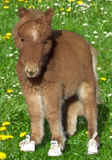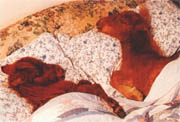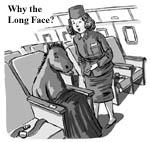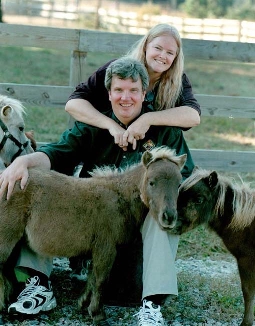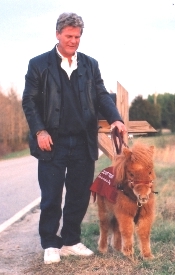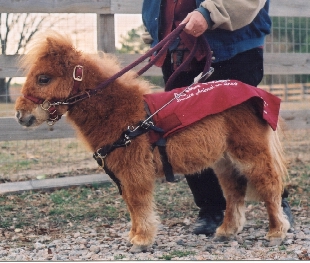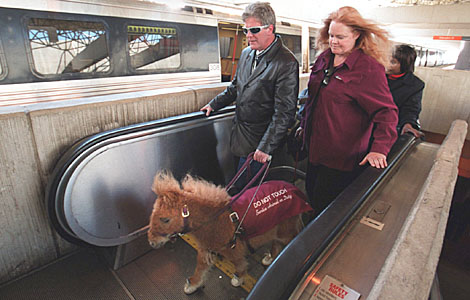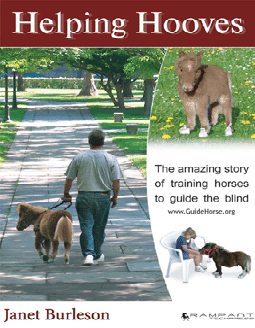|
|
Mom! Look! There’s a horse in this restaurant!
Central-news.com
By Judith A. Grove
Yes. Someday soon, you too may see a horse sharing your favorite
restaurant. But, the horse will probably be smaller than the German
shepherd seeing-eye dog you might expect to see with a blind person.
What you may see someday is a guide horse, a tiny little horse which has
been trained to serve blind people in the same way that dogs have been
trained to do for years. (The horses are not called seeing-eye horses
because the dog people have trademarked that terminology.) You may also
see a little horse-on-a-guide-leash on an el train or a shopping mall
escalator. All guide horses are trained to ride in passenger vehicles
and use escalators and elevators, and some are trained to ride in
busses, taxi cabs, and subway trains.
But, you ask, "Where will the horse sit or stand or ??, in a
restaurant?" Under the table or beside it, like a guide dog. The horses
currently being trained as guide horses are actually called pygmy horses
because they are even smaller than many miniature horses. To be a guide
horse, the horse must be less than 26 inches high at the "withers". (The
withers is the highest point on the horse's back, between the shoulder
blades.) Typically, guide horses weigh between 50 and 100 pounds.
Definitely smaller than most guide dogs.
Who provides such guide horses?
The North Carolina-based Guide Horse Foundation, founded in 1999, trains
the guide horses and makes them available to appropriate handlers.
Currently there are two people using guide horses full time, and these
“handlers” say that their equine guides are performing even beyond their
expectations. The Foundation reports a strong demand for their horses,
and, according to horse trainer Jan Burleson, the originator of the
guide horse idea, nine more little horses are currently in training.
Horses will be provided free of charge to appropriate “handlers” who are
blind. (Although the handler may have to pay to attend the required
horse-human team training.) Handlers do not really own their horses;
they have no right to sell the little horses. If the Foundation finds
that a horse is being misused or abused or otherwise harmed, the
Foundation can take the horse back. Likewise, if the handler wants to
give the horse up, the Foundation will take it back, and when horses
reach “retirement age” when they it is assumed they can no longer
perform their guide duties effectively, the handler can keep the horse
as a companion animal or return it to the Foundation to allow it to live
its life out in comfort.
Why would someone want a guide horse?
The Foundation reports that a Discovery Channel survey showed that 27%
of the people responding indicated that they would prefer a guide horse
if they ever required a guide animal. Why? Why would someone prefer a
guide horse to a guide dog?
Well, some people are horse lovers who just happen to be blind. They may
have grown up around horses, love them, and understand them. Some people
are afraid of dogs, especially dogs large enough to serve as guide dogs,
but would not fear the little horses. Other people may be allergic to
dogs and find horses are an allergy-free alternative-and horses don’t
get fleas. Older people or people who have other physical disabilities,
in addition to blindness, often find a little horse easier to manage
because of the horse’s docile nature. In addition, the horse is sturdy
enough to provide support for the handler rising from a wheelchair.
Then too, many people (blind or sighted) have suffered the grief of
losing a beloved dog, and horses commonly live to be 25-35 years old or
older--much older than dogs. And, if the handler does not need the guide
animal on a 24/7 basis, the horse can live outside, provided proper
shelter is provided for it. (It also can double as a lawn mower.) Yes, a
guide horse can be house-trained and live indoors. It can even lie on
your couch like a dog! To protect their little hooves (they don't wear
metal shoes like traditional horses) and to keep them from slipping on
hard slick surfaces, the little horses sometimes wear tiny little horsey
tennis shoes! Honest.
Why is a horse suited to be a guide animal?
Horses have excellent vision. Because their eyes are mounted on the
sides of their heads, they have nearly 350 degree vision. They can see
almost in a complete circle around them. They also have excellent night
vision and can see clearly in almost total darkness. They are strong and
sturdy and reliable.
Horses are also quite intelligent and excel at tasks that require
long-term memory. They can actually be trained to do many things. One
trainer taught his (full-sized) Arabian to catch a Frisbee! Now he is
trying to teach the horse to throw the Frisbee. All guide horses must
pass a field intelligence test to be accepted into the guide program,
and they are trained to readily accept new experiences. A horse is a
herd animal, and once the trained guide horse bonds with its handler, it
accepts the handler as the “dominant horse,” the herd leader. The horses
undergo hundreds of hours of training, modeled upon the training given
to guide dogs but using “horse psychology.” It takes six months to a
year to complete a horse's training. Horses are taught to respond to
voice commands, and “basic training” includes 23 voice commands. Human
handlers must undergo training in how to work with and use their little
equine companions.
While some people assume that all horses are easily “spooked” by sudden
movement or loud noises, guide horses are selected for their calm
nature; unusually nervous horses or horses with any health problems are
screened out. Guide horses are trained to remain calm in noisy or
chaotic situations; all guide horses undergo the same kind of
desensitization training given to police horses trained for riot-control
Do these horses make good companions?
While they do not seek affection with the intensity that a dog might,
this fact allows the horses to focus more intensely on their guidework.
According to the guide horse trainers, when off duty, many of the little
horses follow their handlers around seeking companionship and affection,
and they enjoy sharing the daily activities of their handlers. The
horses love to be scratched, petted, and groomed. They can be trained to
sleep quietly beside their handlers during the night. Rubbing the
horse’s tummy helps it go to sleep, the experts say.
The little horses often seem to anticipate the desires and wishes of the
handler even before any commands are issued, according to trainers and
observers. One of the goals of the final on-site training with horse and
handler is to increase the bond between human and horse.
The little horse is compatible with other house pets, but it should
never be left alone with a large dog, as large unsupervised dogs can be
a serious threat to the small horses. Neither should the horse be left
in an un-fenced area where large dogs could reach the horse. Like any
companion animal, the horse requires the necessities of life, including
food, water, and shelter. The horse also needs regular medical attention
and a farrier (a person who shoes standard-size horses) to trim his
hooves every six to eight weeks. A horse does not naturally have a
strong smell, and regular grooming and occasional bathing (too much
dries his skin) will assure he is a pleasant companion to live with.
Can guide horses go anywhere guide dogs can go?
The Americans with Disabilities Act (ADA) does not specifically mention
dogs as assistance animals, but the law defines a “service animal” as
any animal that assists the disabled. It is against Federal law to
refuse admittance to any properly trained service animal in public
places, including restaurants, stores and public transportation.
Landlords may not discriminate against a person with an assistance
animal, and miniature horses acting as service animals are exempt from
all local, county and state animal restrictions. Service animals may
only be denied entrance if they pose a risk to safety or health or if
they disrupt the business.
How can someone apply for a guide horse?
The Guide Horse Foundation has a website at www.guidehorse.com. Further
information about the horses is available on this helpful site. For
additional information or to inquire about the application process,
contact the Foundation at info@guidehorse.com.
|
